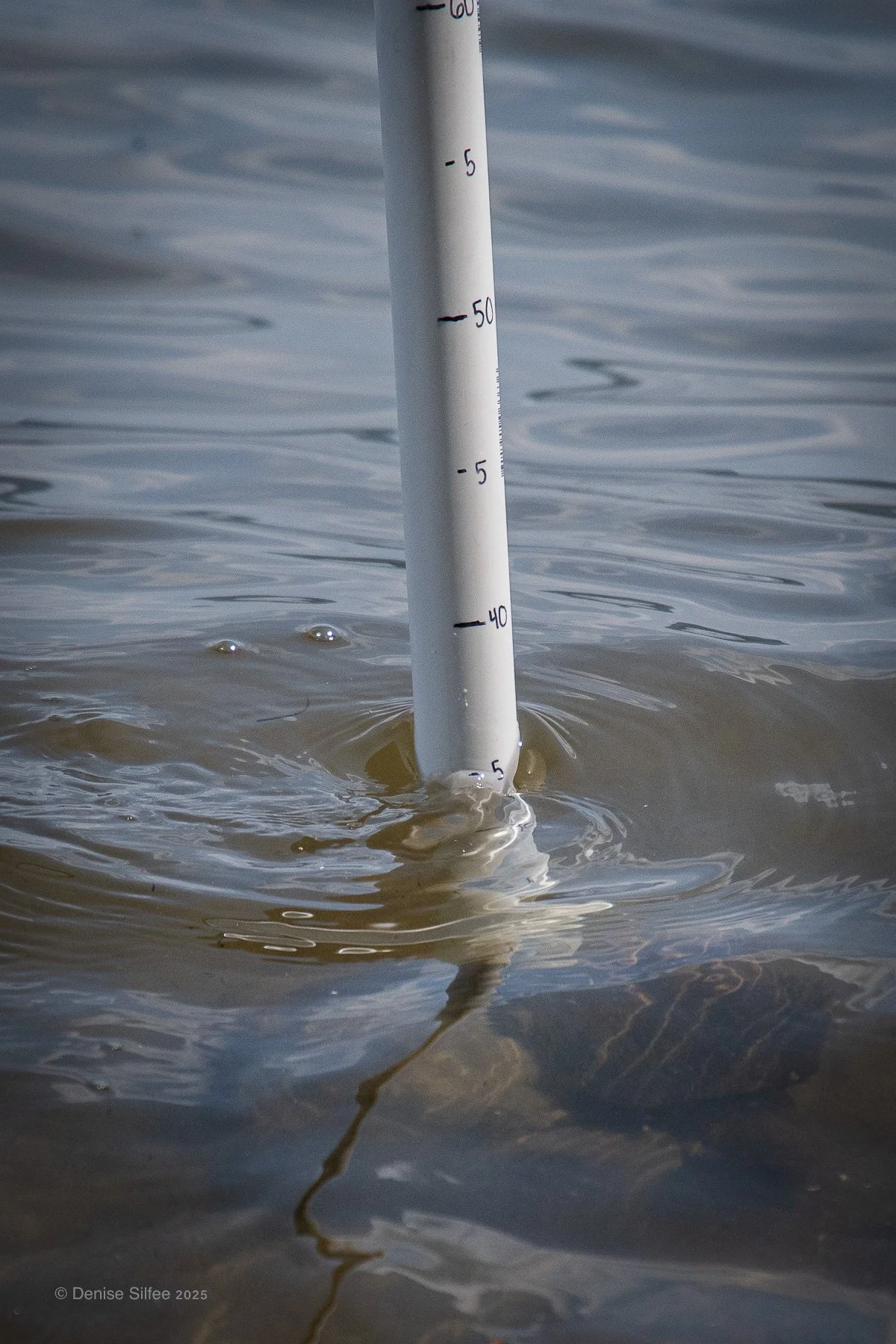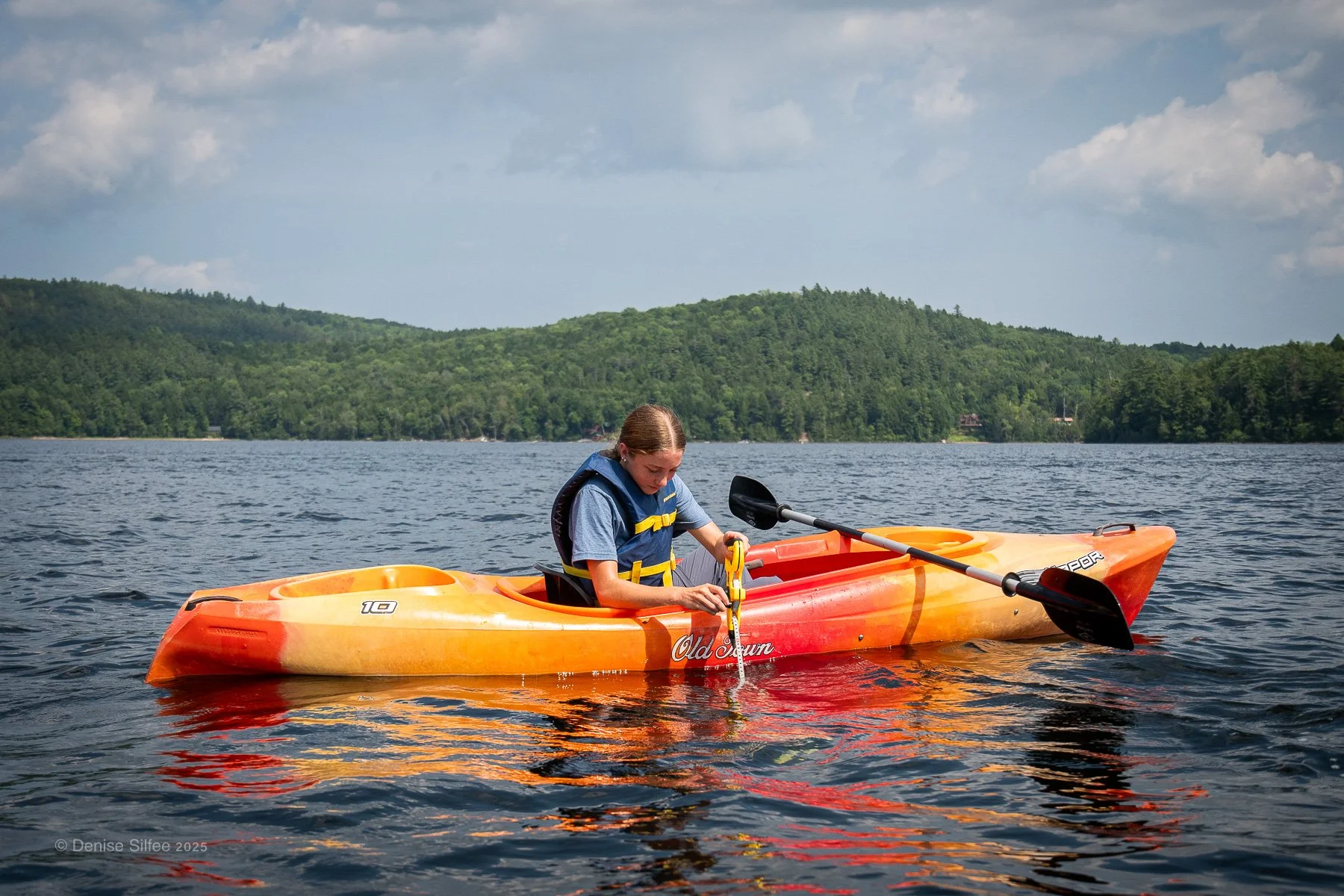Two New Research Projects Developed by Interns This Summer
Words & Images by Denise Silfee, ACLC Director of Education and Communications
Each summer, the Adirondack Center for Loon Conservation (ACLC) partners with State University of New York College of Environmental Science and Forestry (SUNY ESF) Adirondack Ecological Center in Newcomb, in Essex County, NY, to hire and support two research interns. The positions are funded through a grant with the US Fish and Wildlife Service on behalf of the Bouchard Barge 120 Buzzards Bay Oil Spill Trustees. Over the last few years, the interns’ projects have varied between monitoring loons on lakes near Newcomb, assisting with ACLC stewardship programs and conducting outreach in local communities.
This year, the interns’ assignment was a little different: they were tasked with developing two new research studies using methods accessible by the general public.
Interns Brigitte Walla and Emilia Ciesla with a wave height measuring device at Schroon Lake.
The interns
Brigitte Walla is in her senior year as a biology major on the Biodiversity, Ecology and Conservation Track at Smith College in Northampton, MA, this fall. Emilia Ciesla is beginning her masters degree in environmental science this fall at Oregon State University. Brigitte and Emilia interviewed for the research internship along with several other well-qualified candidates, and were ultimately selected for their enthusiasm, experience and professionalism.
Brigitte and Emilia lived on campus at SUNY ESF in Newcomb, NY where they got to interact with other interns and students on site for summer research projects. Part of their internship involved monitoring loons on lakes near Newcomb. They also participated in selected outreach events. The bulk of their internship, however, was devoted to learning about boat impacts and water clarity, and designing two studies that ACLC can offer to community members going forward. While both interns worked together on both studies, Brigitte took the lead on the boat impacts study and Emilia on the water clarity study.
Both interns were advised by Dr. Stacy McNulty, SUNY ESF Associate Director of Research; Natasha Karniski-Keglovits, SUNY ESF Wildlife Biologist; and Griffin Archambault, ACLC Research Biologist.
Boat Impacts Study
The boat impacts study was motivated by an increasing number of questions from community partners about the potential impacts of wake boats on larger Adirondack lakes. Wake boats are motorized boats designed to generate large, surfable waves for water sports like wake boarding and wake surfing. Waves are produced when operated in wakesurf mode, producing waves between two and five feet tall, and have prompted concerns in other states with large lakes about safety for other boaters and lake users, as well as concerns about shoreline erosion, destruction of wildlife habitat, sediment redistribution and spread of invasive species.
For loons, which nest at the water’s edge, there are concerns that waves from wake boats can swamp nests. Loons are also visual hunters, so disrupted water columns can hinder their ability to hunt.
While there are many studies about wake boats in other states and Canada, there are no official studies in the Adirondacks or New York state.
Intern Brigitte Walla calls out boats during a 15-minute boat survey, while Emilia Ciesla checks the notes.
Boats on Schroon Lake during a boat survey.
Brigitte’s first task was to identify what questions to address, then to decide what methods to use for data collection. The methods needed to be ones that community volunteers would be able to reasonably employ.
“At the beginning, the idea of putting together an entire study from scratch was super overwhelming,” said Brigitte. “The involvement of volunteer 'citizen scientists' was something I had not considered before in my own research, either.”
To develop the study, the interns partnered with East Shore Schroon Lake Association (ESSLA), and used Schroon Lake as their pilot lake. Brigitte chose three ways to collect data:
Boat surveys taken in 15-minute increments and categorizing boats as one of four types: non-motorized, motorized, personal watercraft, and wakeboats
Wave height measurements using a PVC measuring pipe with measurements in centimeters written in Sharpie
Distance from shore using a rangefinder, a specialized set of binoculars that can indicate the distance of an object up to 400 meters away
A PVC pipe with measurements marked in centimeters is used as wave height measurement tool.
Working together, the interns collected data on Schroon Lake between July 2 and August 15. In this short window of time, they conducted 56 boat surveys, 44 wave height surveys, and were able to collect data on distance from shore during boat surveys. Some of the preliminary findings were expected ones, such as peak boat-use times (afternoons, weekends). The overwhelming majority of boats maintained a 100-foot or greater distance from shore, with four instances of wake boats operating within 100 feet of shore.
There are no “final” conclusions from Brigitte’s study; more data needs to be collected and over longer periods of time. ACLC plans to offer community members in the Loon Friendly Lakes Certification Program, as well as other interested groups, instructions for collecting data beginning next summer to start to create a larger data sample.
“For the future, it would also be interesting to pair the maximum wave height measurement with areas of interest for loon nesting,” said Brigitte. “If a bird is nesting on a nest raft or on a shore, if a PVC measuring device was positioned in the same cove or near the raft, loon behavior could be recorded in conjunction with boat numbers and wave height measurements during 15-minute surveys to investigate how boats are acting around the birds, whether the nests are being 'waked' often, and how the birds are reacting to that boat pressure.”
Intern Emilia Ciesla holds a do-it-yourself secchi disk.
Water Clarity Study
Water clarity is much-studied in Adirondack Lakes through programs like Citizens Statewide Lake Assessment Program (CSLAP) and Adirondack Lake Assessment Program (ALAP). These programs take water quality samples and use secchi disks to measure water clarity. They require a fee to participate, and the data they collect provides valuable insights into lake water quality over several years and decades.
Secchi disks are round and can be made of different types of materials. The disk is marked with four quadrants in alternating black and white colors, and the whole contraption is attached to rope that is marked with measurements in inches. By lowering the disk into the water and taking notes and measurements at points where the disk is visible or not visible from the surface, information about water transparency and turbidity at different locations, depths, times of day, etc. can be determined.
ACLC is interested in water clarity because loons are visual hunters that rely on a certain amount of clarity to hunt prey. There are potential connections between water clarity and loon body mass, habitat selection and reproductive success. When paired with boat use data, there is the potential to understand how high levels of boat use may impact water clarity at different times of the day and during the week, and investigating what this could mean for loons. Secchi disks are ideal community science tools because they are relatively simple to use and participants can make them themselves if they wish.
This aspect of accessibility appealed to Emilia. “It was exciting to develop something that can be used by anyone, not just researchers,” she said. “I liked being able to test out different methods and really figure out what works and what doesn't. I learned so much about what goes into a research project and how to make an effective research study.”
Intern Emilia Ciesla takes a water clarity measurement using a secchi disk on Schroon Lake.
Making a do-it-yourself secchi disk using a firm plastic plate, electrical tape and rope.
Emilia collected water clarity samples on Schroon Lake, which is considered a high use lake, as well as two other lakes, one considered moderate use and one low use. She collected samples at different times of the day, on different days of the week, and noted weather. The amount of time in the internship limited the ability of collecting enough data to be significant, but allowed for plenty of time to refine the process and create instructions for future volunteers.
Emilia also made a do-it-yourself secchi disk and created step-by-step instructions and filmed a step-by-step video explaining how to create a secchi disk from cheap and easy to obtain materials. ACLC plans to make these instructions available to community partners next summer, possibly holding a secchi disk making event, and to roll out Emilia’s methods for sample collection and measurement recording.
“I hope to see this project turn into something that volunteers or future interns continue to participate in,” Emilia said. “This study has the potential to evaluate the impacts of recreation on water clarity and the data could be valuable for a range of projects from looking at water clarity impacts on loons to broader studies on aquatic ecosystems.”
Going Forward
ACLC plans to roll both of these studies out to interested groups and community volunteers in 2026, and to continue supporting volunteers in data collection for several summers. Brigitte and Emilia’s initiative and professionalism have set the standard for what our research interns can accomplish in a single summer internship, and likely future interns will continue leading these projects.
Check back next spring to learn how to participate.







